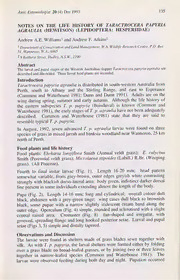
Notes on the life history of Taractrocera papyria agraulia (Hewitson) (Lepidoptera: Hesperiidae) PDF
Preview Notes on the life history of Taractrocera papyria agraulia (Hewitson) (Lepidoptera: Hesperiidae)
Aust. Entomologist 20 (4) Dec 1993 135 NOTES ON THE LIFE HISTORY OF TARACTROCERA PAPYRIA AGRAULIA (HEWITSON) (LEPIDOPTERA: HESPERIIDAE) Andrew A.E. Williams! and Andrew F. Atkins? ! Department of Conservation and Land Management, W.A. Wildlife Research Centre, P.O. Box 51, Wanneroo, W.A., 6065 2 9 Bathurst Street, Dudley, N.S.W., 2290 Abstract The larval and pupal stages of the Western Australian skipper Taractrocera papyria agraulia are described and illustrated. Three larval food plants are recorded. Introduction Taractrocera papyria agraulia is distributed in south-western Australia from Perth, south to Albany and the Stirling Range, and east to Esperance (Common and Waterhouse 1981; Dunn and Dunn 1991). Adults are on the wing during spring, summer and early autumn. Although the life history of the eastern subspecies T. p. papyria (Boisduval) is known (Common and Waterhouse 1981), the early stages of T. p. agraulia have not been adequately described. Common and Waterhouse (1981) state that they are said to resemble typical T. p. papyria. In August, 1992, seven advanced T. p. agraulia larvae were found on three species of grass in mixed jarrah and banksia woodland near Wanneroo, 25 km north of Perth. Food plants and life history Food plants: Ehrharta longiflora Smith (Annual veldt grass); E. calycina Smith (Perennial veldt grass); Microlaena stipoides (Labill.) R.Br. (Weeping grass). (All Poaceae). Fourth to final instar larvae (Fig. 1). Length 16-20 mm; head pattern somewhat variable, frons grey-brown, outer edges greyish white contrasting strongly with blackish dorso-lateral area; body green, indistinct darker dorsal line present in some individuals extending almost the length of the body. Pupa (Fig. 2). Length 14-16 mm; long and cylindrical; overall colour dull black, abdomen with a grey-green tinge; wing cases dull black to brownish black, some pupae with a narrow slightly iridescent cream band along the outer edge. Operculum (Fig. 4) simple, rounded and sclerotised with a slight central raised area. Cremaster (Fig. 8) fan-shaped and irregular, with grooved, spreading flange and long hooked posterior setae. Larval and pupal setae (Figs 3, 5) simple and distally tapered. Observations and Discussion The larvae were found in shelters made of grass blades sewn together with silk. As with T. p. papyria, the larval shelters were formed either by folding over a grass blade on broad-leafed grasses, or by joining two or three leaves together in narrow-leafed species (Common and Waterhouse 1981). The larvae were observed feeding during both day and night. Pupation occurred 136 Aust. Entomologist 20 (4) Dec 1993 Figs 1-8. (1-5) Life history of T. p. agraulia from Wanneroo, Western Australia: (1) final instar larva, dorsal and lateral view (scale line = 5 mm); (2) pupa, dorsal and lateral view (scale line = 5 mm); (3) larval seta (scale line = 0.5mm); (4) pupa, frons view (scale line = 2 mm); (5) pupal seta (scale line = 0.5 mm); (6-8) cremaster, dorsal view (scale line = 2 mm) of: (6) T. p. papyria from Bolivia Hill, New South Wales; (7) T. p. papyria from Mossy Point, New South Wales; (8) T. p. agraulia from Wanneroo, Western Australia. Aust. Entomologist 20 (4) Dec 1993 137 within the shelters, the entrances of which were partially sealed with fine strands of silk. Pupation time was 29 to 30 days. It is interesting to note that of the seven larvae collected, six were on the introduced veldt grasses, E. longiflora and E. calycina, which are both widespread and common in south western Australia. Only one larva was found on the native grass, M. stipoides, which is also a known food plant of the nominate subspecies (Common and Waterhouse 1981). Differences were found between the pupa of T. p. agraulia and T. p. papyria. In specimens from Wanneroo, Western Australia the cremaster has an irregular, fan-shaped flange with moderate dorso-lateral spines. The cremaster of specimens from two areas in New South Wales (Figs 6, 7) is more rounded with a definite rimmed dish-shaped flange with prominent dorso-lateral spines. The significance of these structural differences between western and eastern populations has yet to be established, but may prove to be specifically important. In other Hesperiinae genera (e.g. Telicota Moore), distinguishing specific characters are provided by cremaster morphology (AFA pers. obs.). Furthermore differences in adult maculation between the two subspecies, particularly on the underside of the hindwing, are also significant. The underside of the hindwing of specimens from Western Australia is covered with golden-orange scales and lacks the oblique silver- white markings found in specimens from eastern Australia. The conspecific status of T. p. papyria and T. p. agraulia has been retained in the absence of any known structural differences in their genitalia. If future examination shows differences, then full species status for T. p. agraulia should be considered. Voucher specimens pertinent to this paper are lodged in the Insect Collection of the Western Australian Department of Conservation and Land Management. Acknowledgment Greg Keighery of the Department of Conservation and Land Management identified the food plant specimens. References COMMON, LF.B. and WATERHOUSE, D.F. 1981. Butterflies of Australia. Pp. xiv + 682. Angus and Robertson, Sydney. DUNN, K.L. and DUNN, L.E. 1991. Review of Australian Butterflies : distribution, life history and taxonomy. Part2 : Family Hesperiidae. Privately published, Melbourne.
